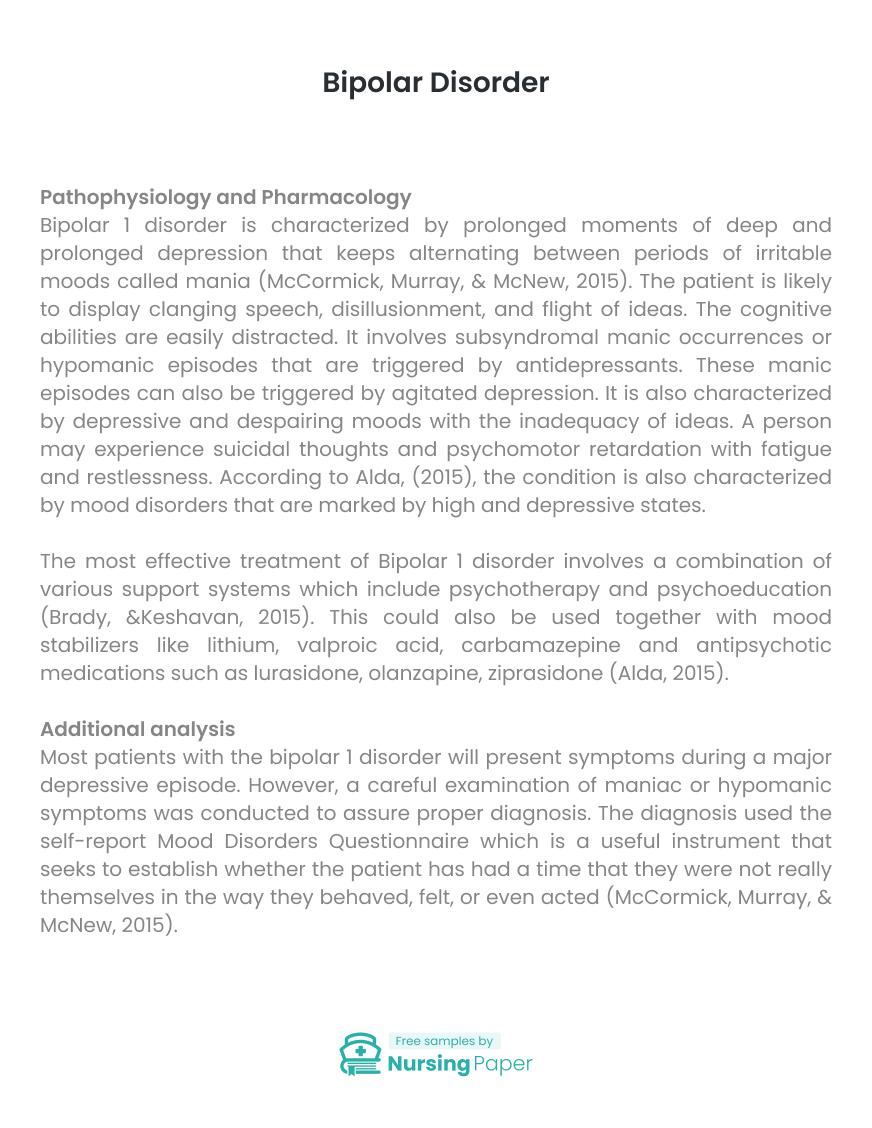
Pathophysiology and Pharmacology
Bipolar 1 disorder is characterized by prolonged moments of deep and prolonged depression that keeps alternating between periods of irritable moods called mania (McCormick, Murray, & McNew, 2015). The patient is likely to display clanging speech, disillusionment, and flight of ideas. The cognitive abilities are easily distracted. It involves subsyndromal manic occurrences or hypomanic episodes that are triggered by antidepressants. These manic episodes can also be triggered by agitated depression. It is also characterized by depressive and despairing moods with the inadequacy of ideas. A person may experience suicidal thoughts and psychomotor retardation with fatigue and restlessness. According to Alda, (2015), the condition is also characterized by mood disorders that are marked by high and depressive states.
The most effective treatment of Bipolar 1 disorder involves a combination of various support systems which include psychotherapy and psychoeducation (Brady, &Keshavan, 2015). This could also be used together with mood stabilizers like lithium, valproic acid, carbamazepine and antipsychotic medications such as lurasidone, olanzapine, ziprasidone (Alda, 2015).


Additional Analysis
Most patients with the bipolar 1 disorder will present symptoms during a major depressive episode. However, a careful examination of maniac or hypomanic symptoms was conducted to assure proper diagnosis. The diagnosis used the self-report Mood Disorders Questionnaire which is a useful instrument that seeks to establish whether the patient has had a time that they were not really themselves in the way they behaved, felt, or even acted (McCormick, Murray, & McNew, 2015). The questionnaire sought to establish the frequency of the mood changes and if the changes were problematic and the intensity of the problem.
Laboratory tests are also essential so as to rule out other disorders and provide critical information that would assure correct and safe medication plan. The laboratory tests that were done included thyroid function test, rapid plasma reagin test, drug test, test B12 levels, and a historical analysis that would detect other causes of mood disorders (Alda, 2015). A complete blood count, liver functionality, and BMI index tests were necessary before starting the treatment with mood stabilizers and antipsychotic medications.
Follow-up
During the second visit to the clinic, the patient had suppressed symptoms of the disorder with reduced frequency and intensity of the manic and depressed episodes. The patient body was able to function well with minimal interruptions. The patient is able to attend their life well and lead a stable and productive life. The patient may have made considerable steps to recovery but more therapy and medication are required to ensure that the patient does not slide back to intense episodes of manic and depression. The patient is able to differentiate the disorder symptoms and the real themselves. This is mainly by observing how the disorder distorts their behavior.

Quality
Bipolar 1 disorder can be influenced by genetic conditions. In future, I will investigate if the potential patient has a family history of bipolar because bipolar 1 is highest possible when the disorder is present in the family. I would also consider factors such as stress, emotional status, self-esteem and inadequate support system as they are all huge contributors to the disorder and would need to be addressed for the condition to be cured.
Coding and Billing
2018 ICD-10-CM (International Classification of Diseases, 10th revision, Clinical Modification), Diagnosis Code F31.9
1. Alda, M. (2015). Lithium in the treatment of bipolar disorder: pharmacology and pharmacogenetics. Molecular Psychiatry, 20, 6, 661-70.
2. Brady, R. O., &Keshavan, M. (2015). Emergent treatments based on the pathophysiology of bipolar disorder: A selective review. Asian Journal of Psychiatry, 18, 15-21.
3. McCormick, U., Murray, B., & McNew, B. (2015). Diagnosis and treatment of patients with bipolar disorder: A review for advanced practice nurses. Journal of the American Association of Nurse Practitioners, 27, 9, 530-42.



The download will start shortly.

The download will start shortly.
 Subject:
Medicine
Subject:
Medicine  Number of pages: 3
Number of pages: 3  Subject:
Medicine
Subject:
Medicine  Number of pages: 2
Number of pages: 2  Subject:
Health and Social Care
Subject:
Health and Social Care  Number of pages: 9
Number of pages: 9  Subject:
Health and Social Care
Subject:
Health and Social Care  Number of pages: 2
Number of pages: 2  Subject:
Health and Social Care
Subject:
Health and Social Care  Number of pages: 8
Number of pages: 8  Subject:
Nursing
Subject:
Nursing  Number of pages: 3
Number of pages: 3  Subject:
Medicine
Subject:
Medicine  Number of pages: 2
Number of pages: 2  Subject:
Medicine
Subject:
Medicine  Number of pages: 2
Number of pages: 2  Subject:
Medicine
Subject:
Medicine  Number of pages: 4
Number of pages: 4  Subject:
Medicine
Subject:
Medicine  Number of pages: 4
Number of pages: 4  Subject:
Health and Social Care
Subject:
Health and Social Care  Number of pages: 10
Number of pages: 10  Subject:
Medicine
Subject:
Medicine  Number of pages: 3
Number of pages: 3  Subject:
Medicine
Subject:
Medicine  Number of pages: 2
Number of pages: 2  Subject:
Medicine
Subject:
Medicine  Number of pages: 2
Number of pages: 2  Subject:
Health and Social Care
Subject:
Health and Social Care  Number of pages: 2
Number of pages: 2 
